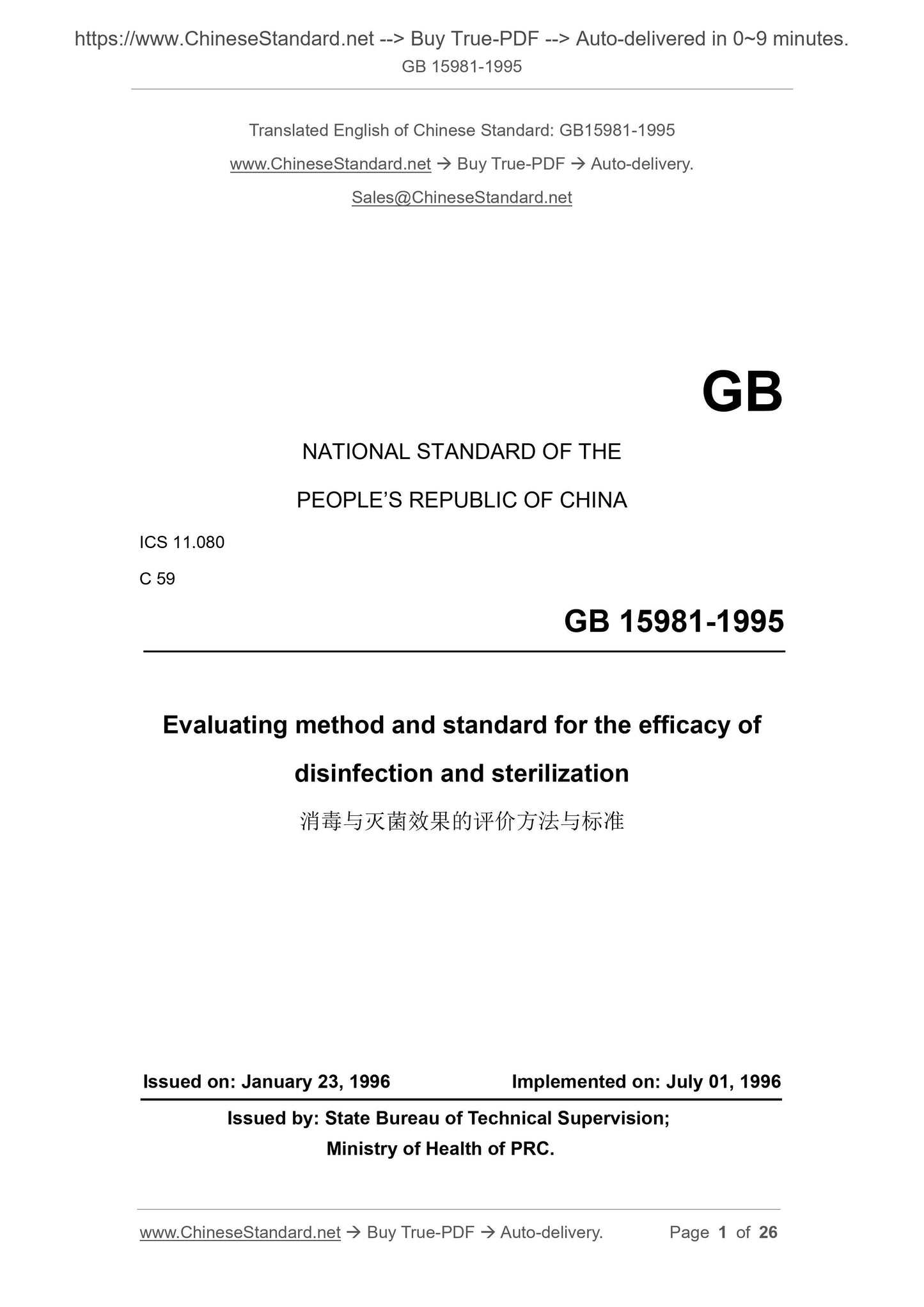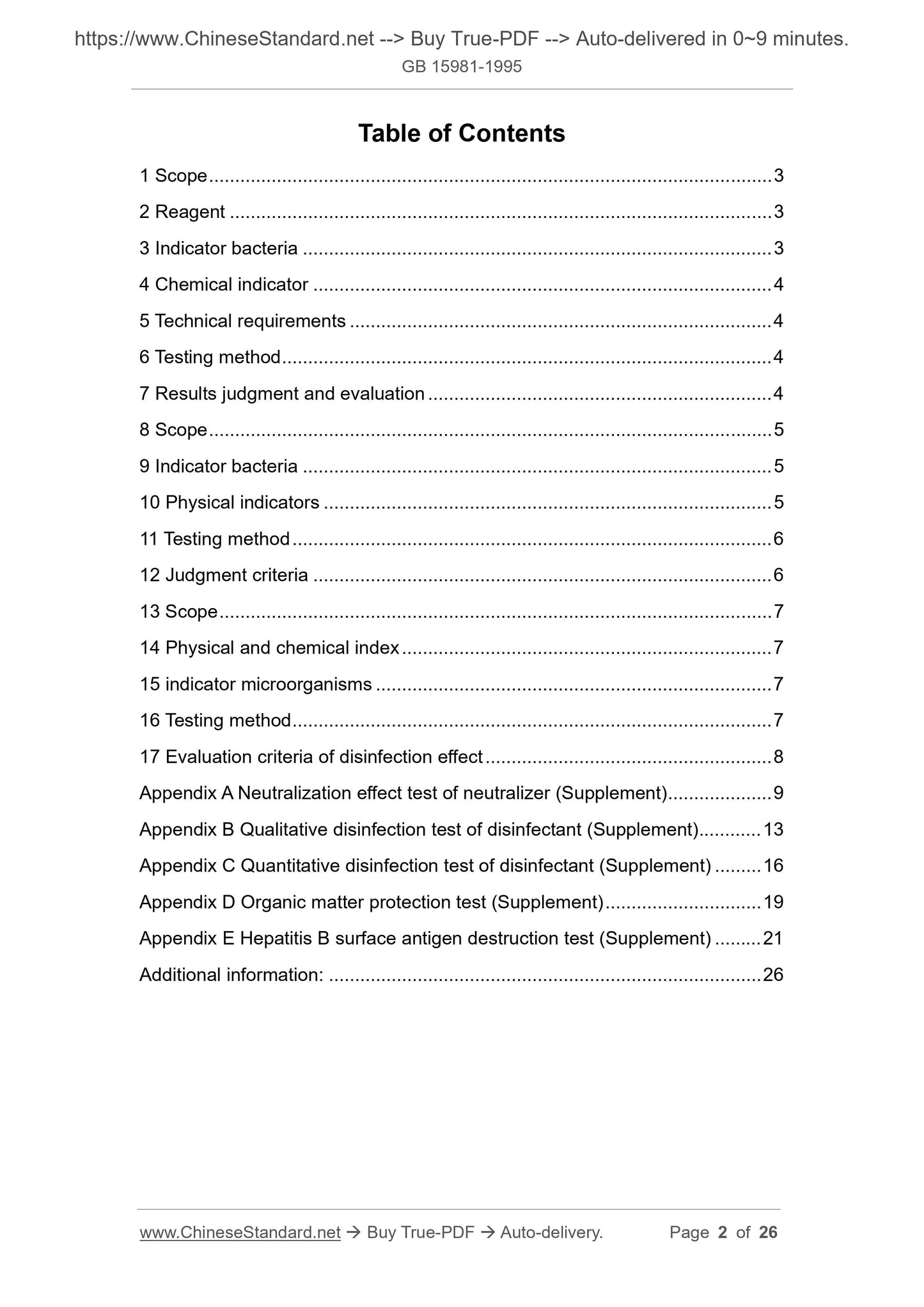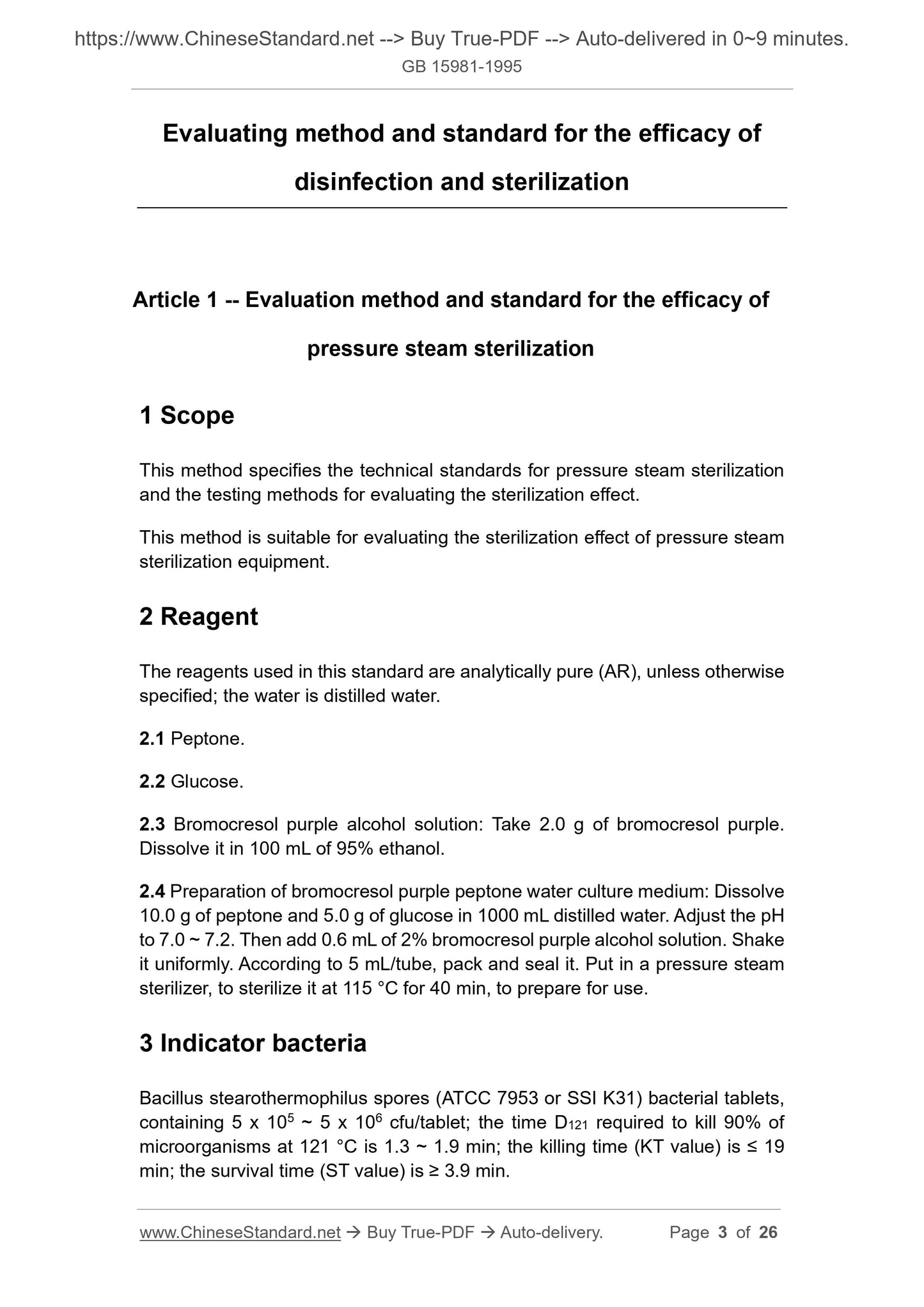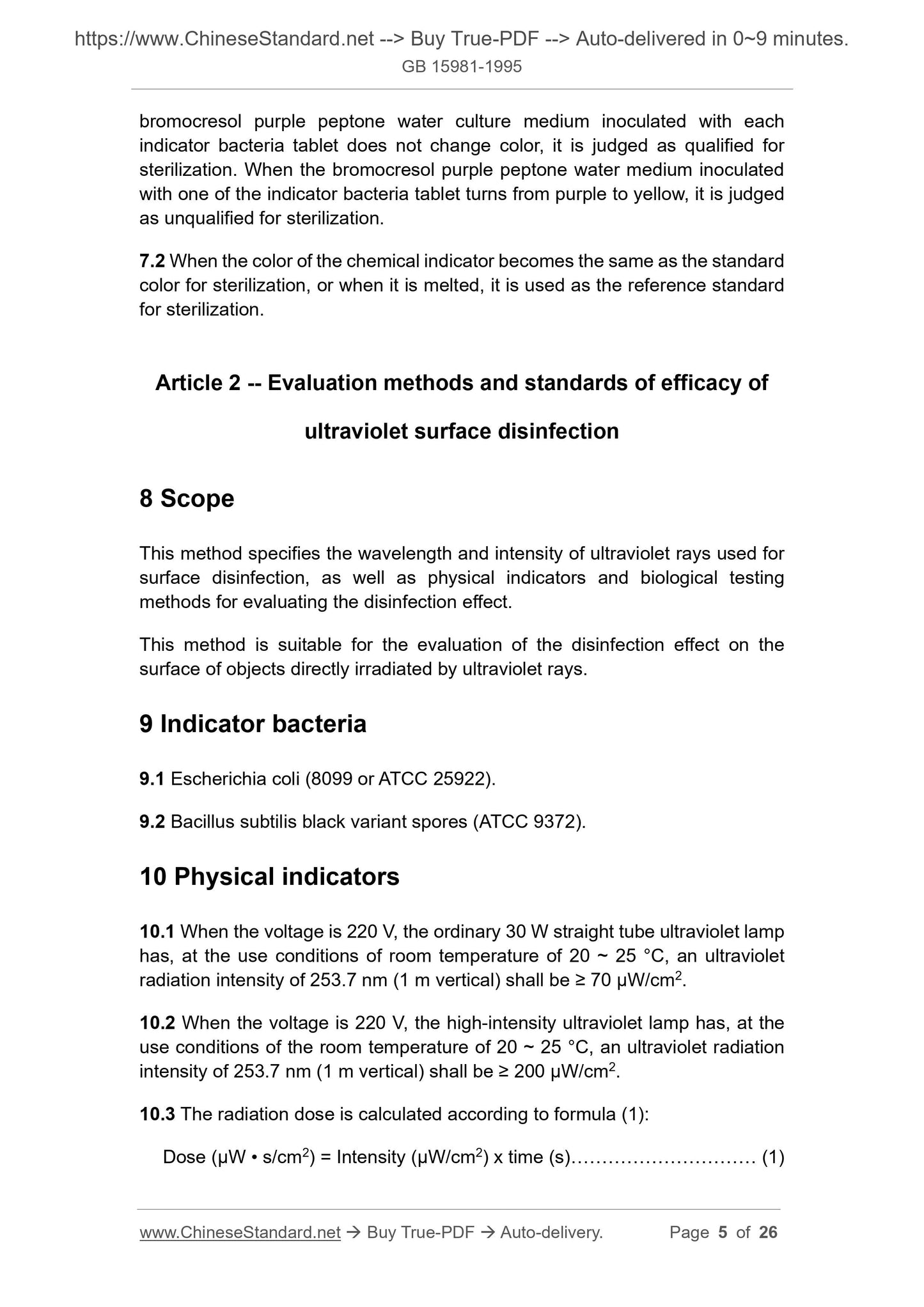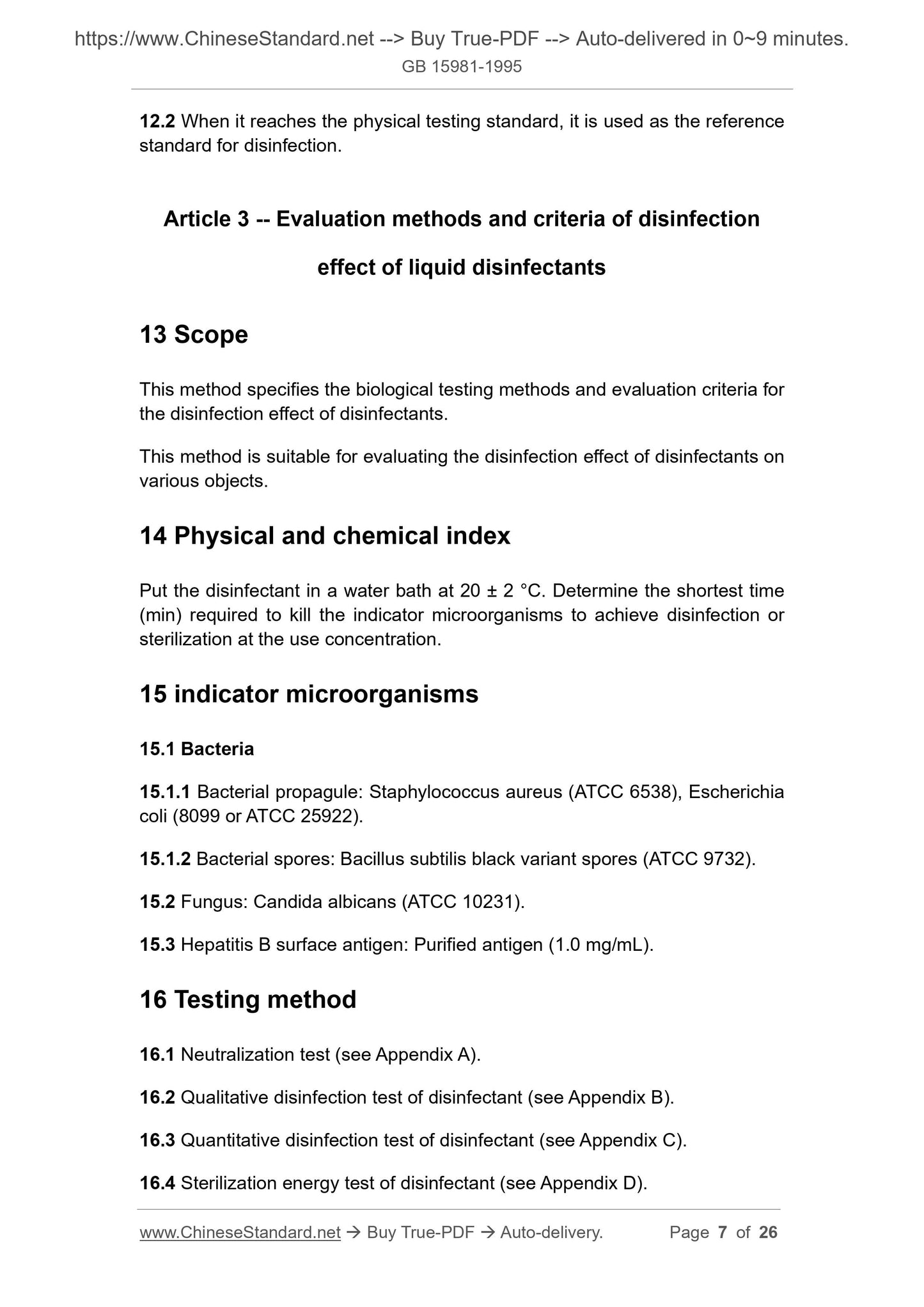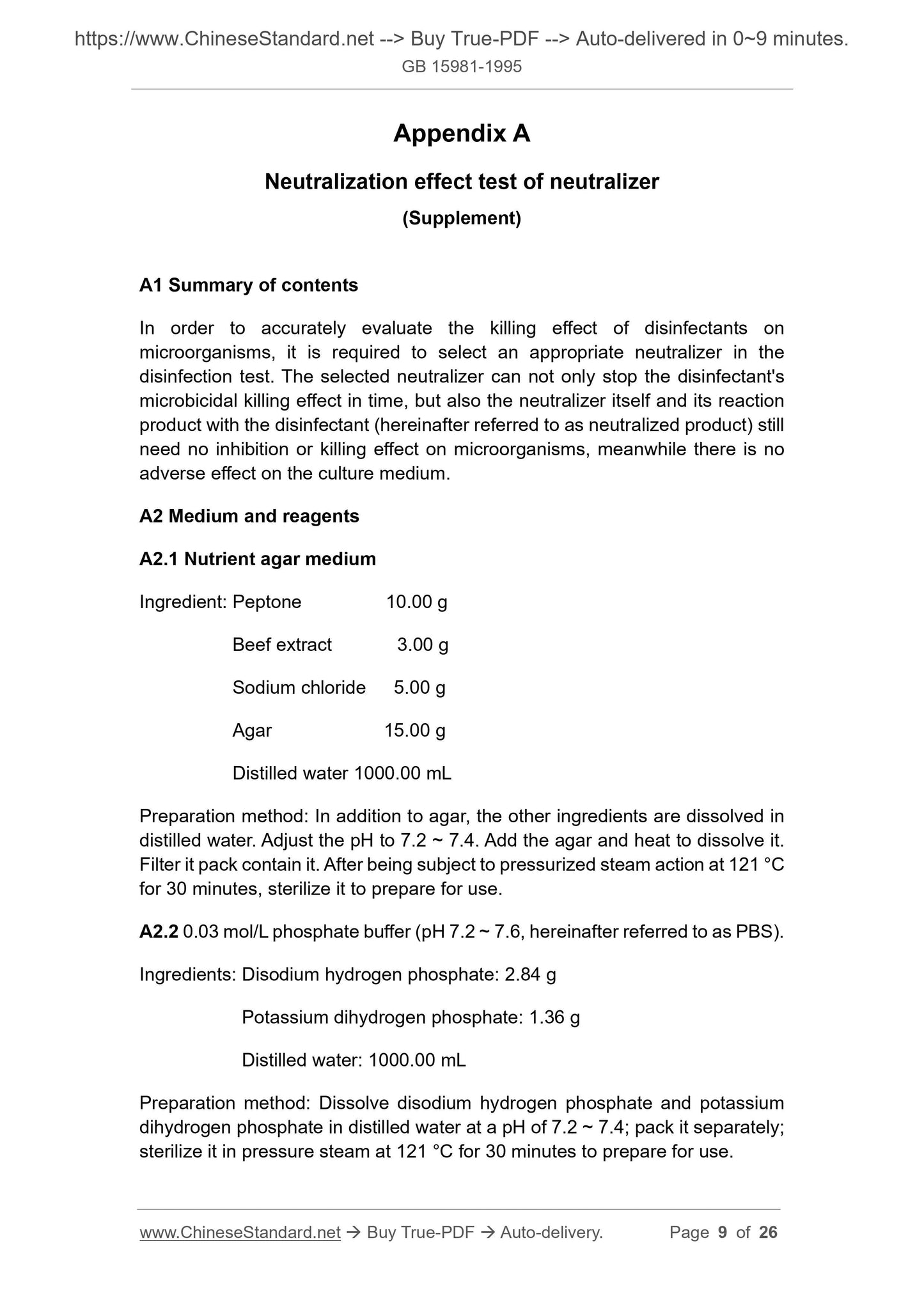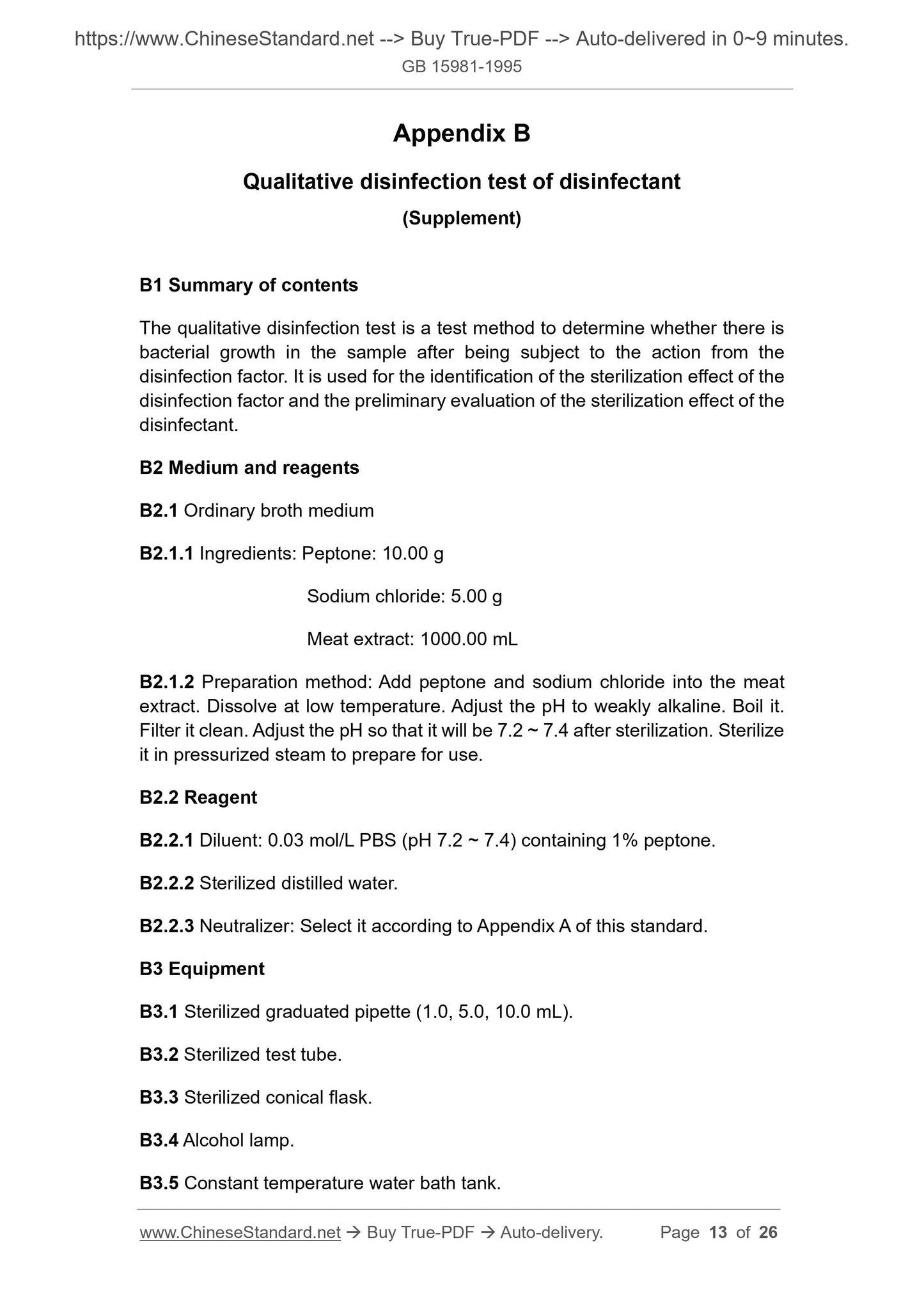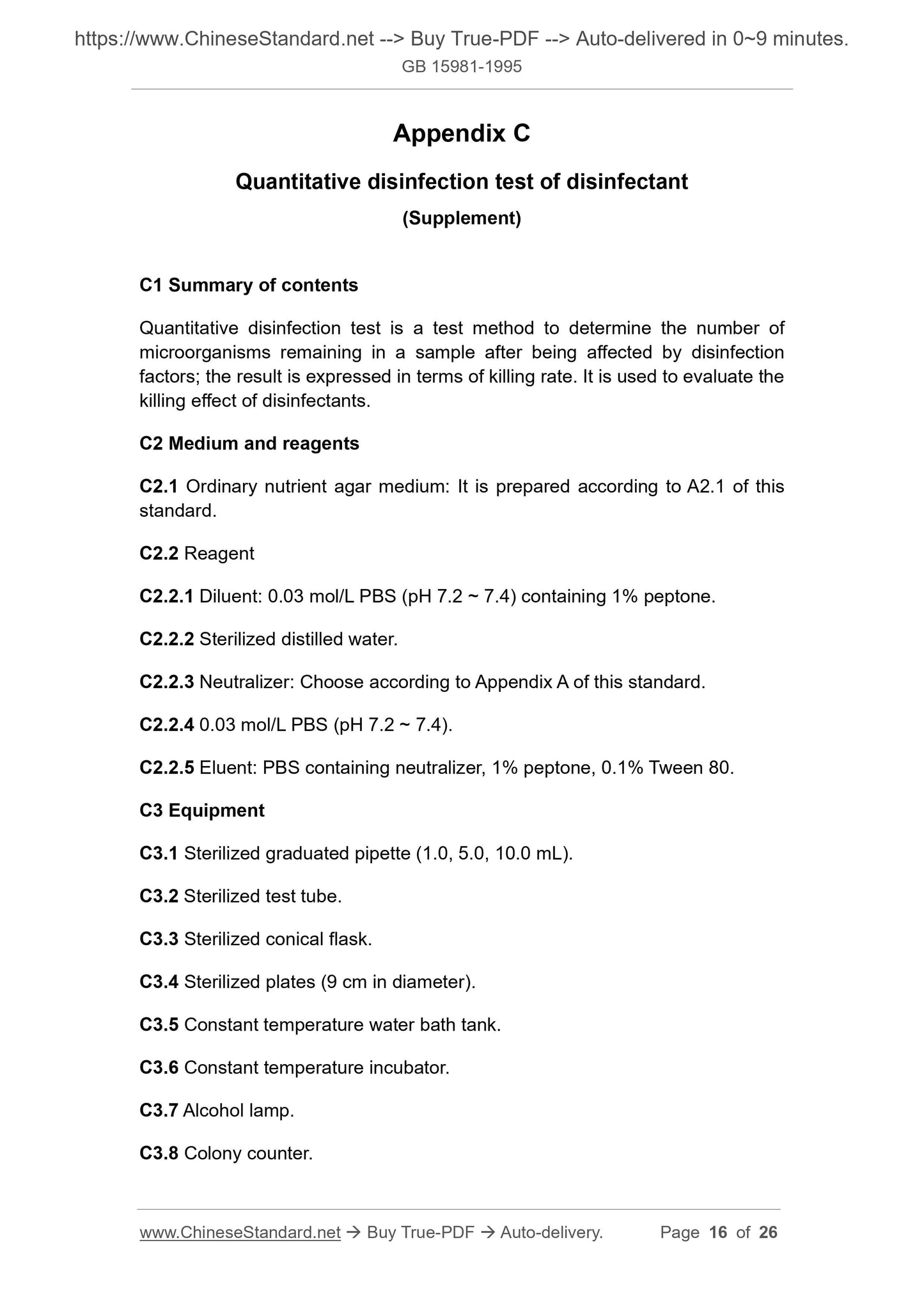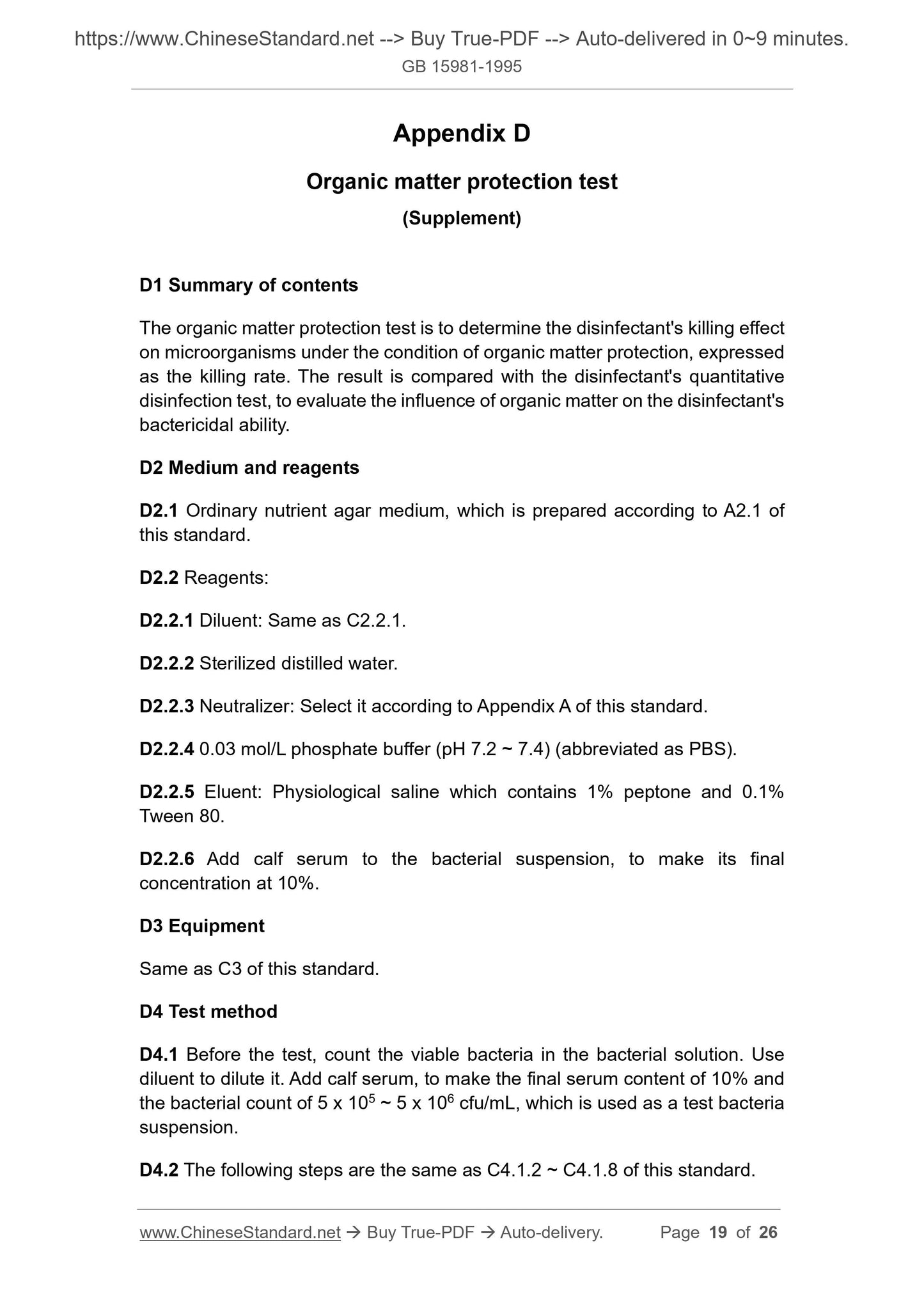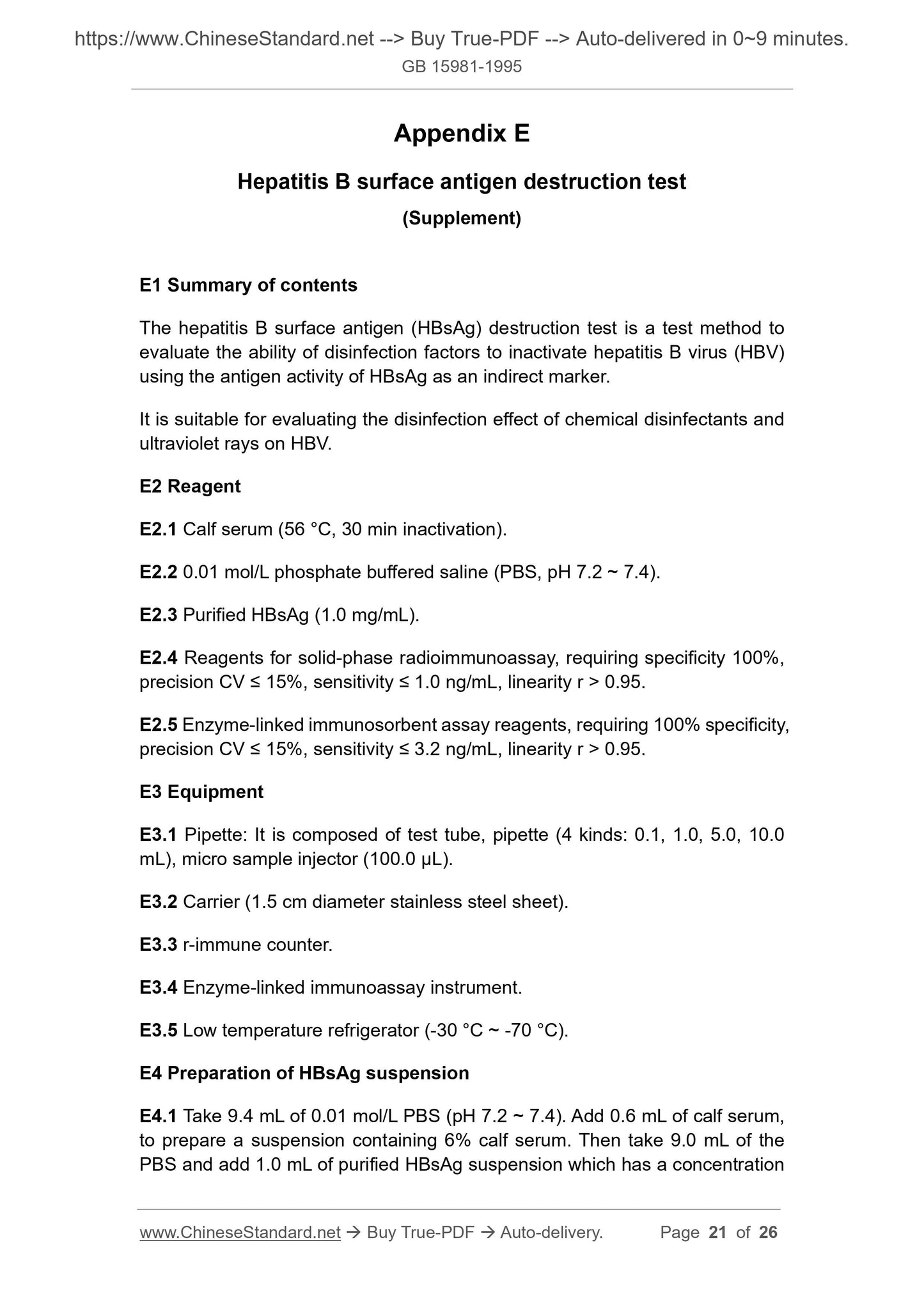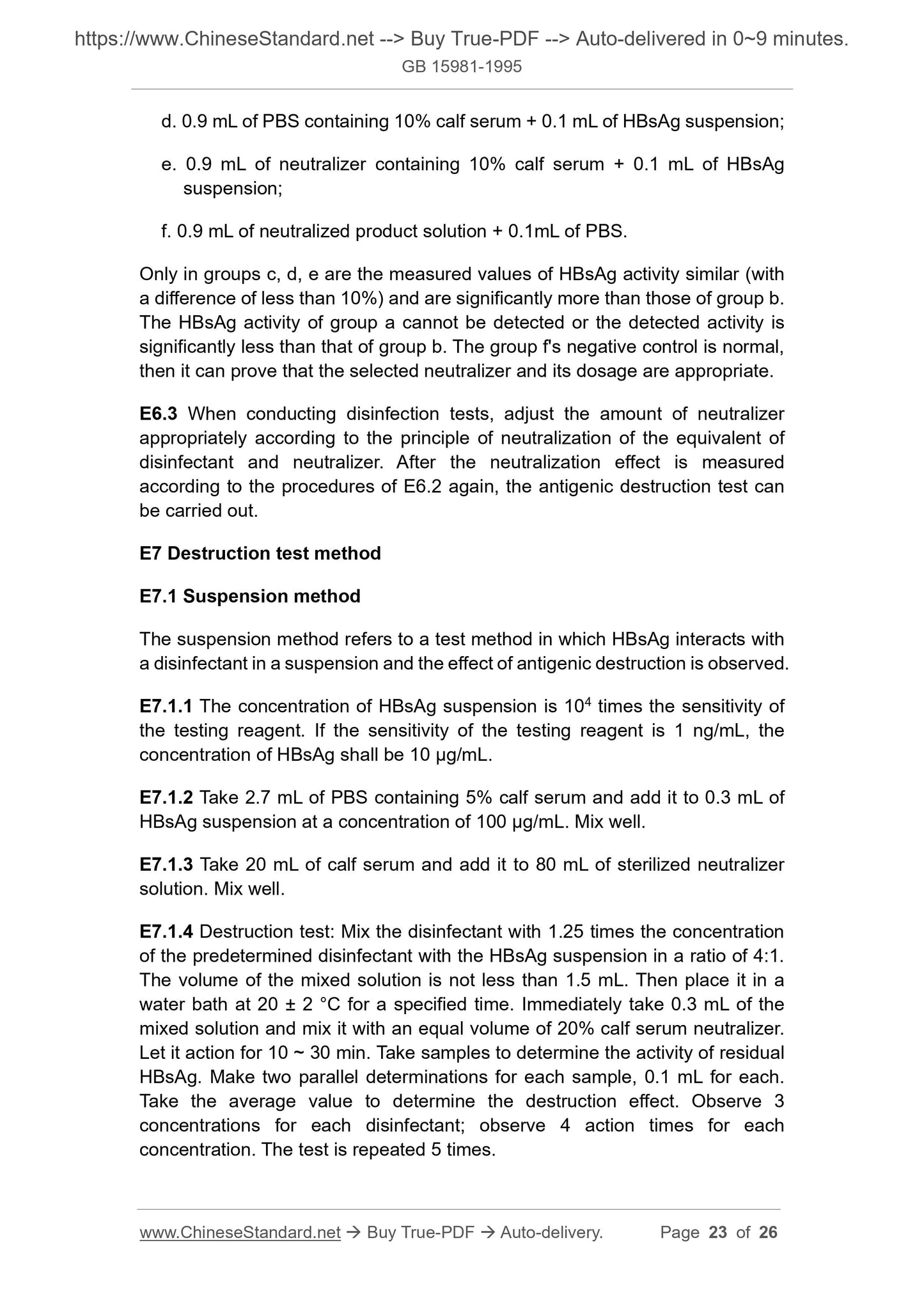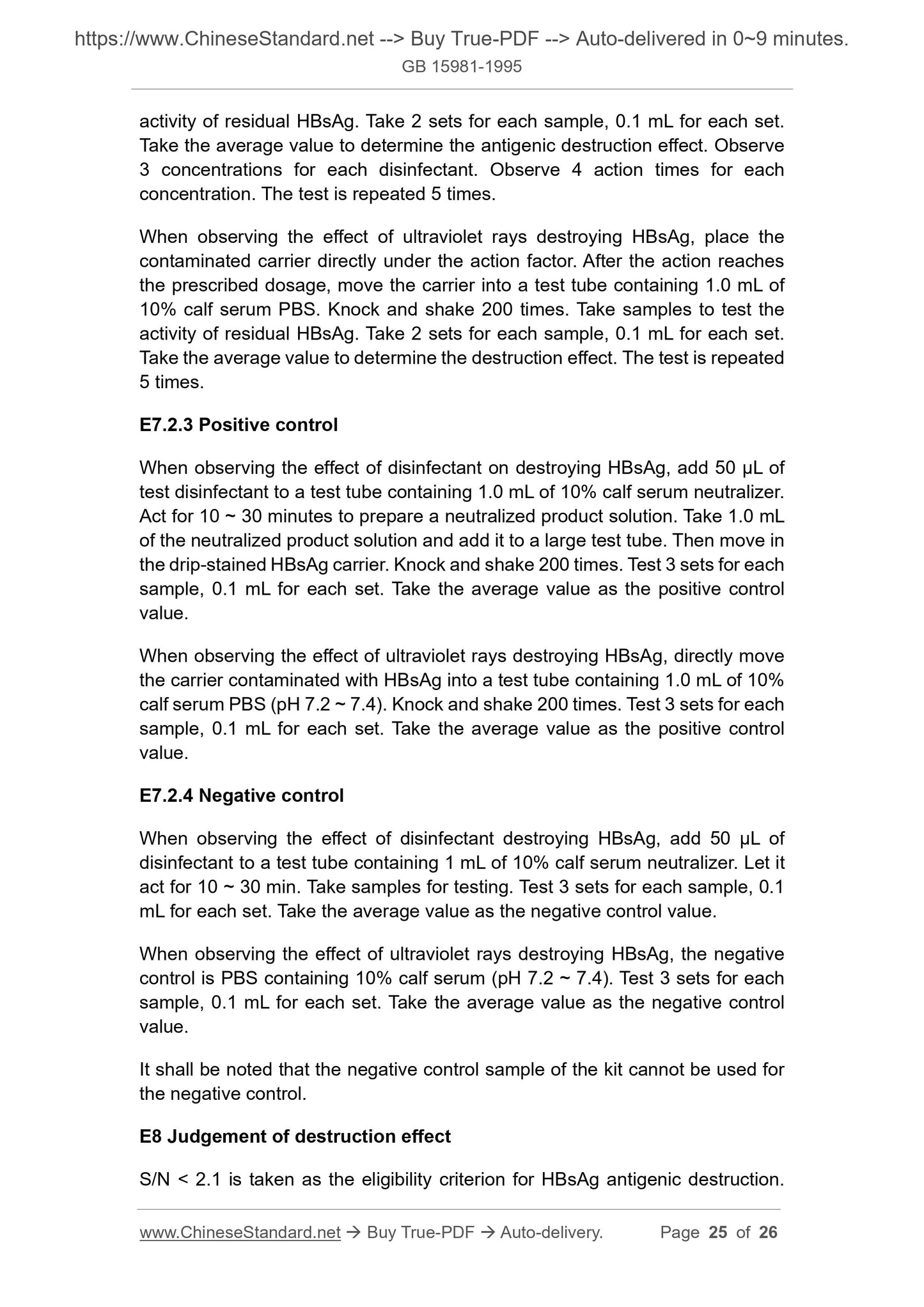1
/
of
12
PayPal, credit cards. Download editable-PDF & invoice in 1 second!
GB 15981-1995 English PDF (GB15981-1995)
GB 15981-1995 English PDF (GB15981-1995)
Regular price
$155.00 USD
Regular price
Sale price
$155.00 USD
Unit price
/
per
Shipping calculated at checkout.
Couldn't load pickup availability
Delivery: 3 seconds. Download true-PDF + Invoice.Newer version: (Replacing this standard) GB/T 15981-2021
Get QUOTATION in 1-minute: Click GB 15981-1995
Historical versions: GB 15981-1995
Preview True-PDF (Reload/Scroll if blank)
GB 15981-1995: Evaluating method and standard for the efficacy of disinfection and sterilization
GB 15981-1995
GB
NATIONAL STANDARD OF THE
PEOPLE’S REPUBLIC OF CHINA
ICS 11.080
C 59
Evaluating method and standard for the efficacy of
disinfection and sterilization
ISSUED ON: JANUARY 23, 1996
IMPLEMENTED ON: JULY 01, 1996
Issued by: State Bureau of Technical Supervision;
Ministry of Health of PRC.
Table of Contents
1 Scope ... 3
2 Reagent ... 3
3 Indicator bacteria ... 3
4 Chemical indicator ... 4
5 Technical requirements ... 4
6 Testing method ... 4
7 Results judgment and evaluation ... 4
8 Scope ... 5
9 Indicator bacteria ... 5
10 Physical indicators ... 5
11 Testing method ... 6
12 Judgment criteria ... 6
13 Scope ... 7
14 Physical and chemical index ... 7
15 indicator microorganisms ... 7
16 Testing method ... 7
17 Evaluation criteria of disinfection effect ... 8
Appendix A Neutralization effect test of neutralizer (Supplement) ... 9
Appendix B Qualitative disinfection test of disinfectant (Supplement) ... 13
Appendix C Quantitative disinfection test of disinfectant (Supplement) ... 16
Appendix D Organic matter protection test (Supplement) ... 19
Appendix E Hepatitis B surface antigen destruction test (Supplement) ... 21
Additional information: ... 26
Evaluating method and standard for the efficacy of
disinfection and sterilization
Article 1 -- Evaluation method and standard for the efficacy of
pressure steam sterilization
1 Scope
This method specifies the technical standards for pressure steam sterilization
and the testing methods for evaluating the sterilization effect.
This method is suitable for evaluating the sterilization effect of pressure steam
sterilization equipment.
2 Reagent
The reagents used in this standard are analytically pure (AR), unless otherwise
specified; the water is distilled water.
2.1 Peptone.
2.2 Glucose.
2.3 Bromocresol purple alcohol solution: Take 2.0 g of bromocresol purple.
Dissolve it in 100 mL of 95% ethanol.
2.4 Preparation of bromocresol purple peptone water culture medium: Dissolve
10.0 g of peptone and 5.0 g of glucose in 1000 mL distilled water. Adjust the pH
to 7.0 ~ 7.2. Then add 0.6 mL of 2% bromocresol purple alcohol solution. Shake
it uniformly. According to 5 mL/tube, pack and seal it. Put in a pressure steam
sterilizer, to sterilize it at 115 °C for 40 min, to prepare for use.
3 Indicator bacteria
Bacillus stearothermophilus spores (ATCC 7953 or SSI K31) bacterial tablets,
containing 5 x 105 ~ 5 x 106 cfu/tablet; the time D121 required to kill 90% of
microorganisms at 121 °C is 1.3 ~ 1.9 min; the killing time (KT value) is ≤ 19
min; the survival time (ST value) is ≥ 3.9 min.
bromocresol purple peptone water culture medium inoculated with each
indicator bacteria tablet does not change color, it is judged as qualified for
sterilization. When the bromocresol purple peptone water medium inoculated
with one of the indicator bacteria tablet turns from purple to yellow, it is judged
as unqualified for sterilization.
7.2 When the color of the chemical indicator becomes the same as the standard
color for sterilization, or when it is melted, it is used as the reference standard
for sterilization.
Article 2 -- Evaluation methods and standards of efficacy of
ultraviolet surface disinfection
8 Scope
This method specifies the wavelength and intensity of ultraviolet rays used for
surface disinfection, as well as physical indicators and biological testing
methods for evaluating the disinfection effect.
This method is suitable for the evaluation of the disinfection effect on the
surface of objects directly irradiated by ultraviolet rays.
9 Indicator bacteria
9.1 Escherichia coli (8099 or ATCC 25922).
9.2 Bacillus subtilis black variant spores (ATCC 9372).
10 Physical indicators
10.1 When the voltage is 220 V, the ordinary 30 W straight tube ultraviolet lamp
has, at the use conditions of room temperature of 20 ~ 25 °C, an ultraviolet
radiation intensity of 253.7 nm (1 m vertical) shall be ≥ 70 µW/cm2.
10.2 When the voltage is 220 V, the high-intensity ultraviolet lamp has, at the
use conditions of the room temperature of 20 ~ 25 °C, an ultraviolet radiation
intensity of 253.7 nm (1 m vertical) shall be ≥ 200 µW/cm2.
10.3 The radiation dose is calculated according to formula (1):
Dose (μW • s/cm2) = Intensity (μW/cm2) x time (s)………………………… (1)
12.2 When it reaches the physical testing standard, it is used as the reference
standard for disinfection.
Article 3 -- Evaluation methods and criteria of disinfection
effect of liquid disinfectants
13 Scope
This method specifies the biological testing methods and evaluation criteria for
the disinfection effect of disinfectants.
This method is suitable for evaluating the disinfection effect of disinfectants on
various objects.
14 Physical and chemical index
Put the disinfectant in a water bath at 20 ± 2 °C. Determine the shortest time
(min) required to kill the indicator microorganisms to achieve disinfection or
sterilization at the use concentration.
15 indicator microorganisms
15.1 Bacteria
15.1.1 Bacterial propagule: Staphylococcus aureus (ATCC 6538), Escherichia
coli (8099 or ATCC 25922).
15.1.2 Bacterial spores: Bacillus subtilis black variant spores (ATCC 9732).
15.2 Fungus: Candida albicans (ATCC 10231).
15.3 Hepatitis B surface antigen: Purified antigen (1.0 mg/mL).
16 Testing method
16.1 Neutralization test (see Appendix A).
16.2 Qualitative disinfection test of disinfectant (see Appendix B).
16.3 Quantitative disinfection test of disinfectant (see Appendix C).
16.4 Sterilization energy test of disinfectant (see Appendix D).
Appendix A
Neutralization effect test of neutralizer
(Supplement)
A1 Summary of contents
In order to accurately evaluate the killing effect of disinfectants on
microorganisms, it is required to select an appropriate neutralizer in the
disinfection test. The selected neutralizer can not only stop the disinfectant's
microbicidal killing effect in time, but also the neutralizer itself and its reaction
product with the disinfectant (hereinafter referred to as neutralized product) still
need no inhibition or killing effect on microorganisms, meanwhile there is no
adverse effect on the culture medium.
A2 Medium and reagents
A2.1 Nutrient agar medium
Ingredient: Peptone 10.00 g
Beef extract 3.00 g
Sodium chloride 5.00 g
Agar 15.00 g
Distilled water 1000.00 mL
Preparation method: In addition to agar, the other ingredients are dissolved in
distilled water. Adjust the pH to 7.2 ~ 7.4. Add the agar and heat to dissolve it.
Filter it pack contain it. After being subject to pressurized steam action at 121 °C
for 30 minutes, sterilize it to prepare for use.
A2.2 0.03 mol/L phosphate buffer (pH 7.2 ~ 7.6, hereinafter referred to as PBS).
Ingredients: Disodium hydrogen phosphate: 2.84 g
Potassium dihydrogen phosphate: 1.36 g
Distilled water: 1000.00 mL
Preparation method: Dissolve disodium hydrogen phosphate and potassium
dihydrogen phosphate in distilled water at a pH of 7.2 ~ 7.4; pack it separately;
sterilize it in pressure steam at 121 °C for 30 minutes to prepare for use.
Appendix B
Qualitative disinfection test of disinfectant
(Supplement)
B1 Summary of contents
The qualitative disinfection test is a test method to determine whether there is
bacterial growth in the sample after being subject to the action...
Get QUOTATION in 1-minute: Click GB 15981-1995
Historical versions: GB 15981-1995
Preview True-PDF (Reload/Scroll if blank)
GB 15981-1995: Evaluating method and standard for the efficacy of disinfection and sterilization
GB 15981-1995
GB
NATIONAL STANDARD OF THE
PEOPLE’S REPUBLIC OF CHINA
ICS 11.080
C 59
Evaluating method and standard for the efficacy of
disinfection and sterilization
ISSUED ON: JANUARY 23, 1996
IMPLEMENTED ON: JULY 01, 1996
Issued by: State Bureau of Technical Supervision;
Ministry of Health of PRC.
Table of Contents
1 Scope ... 3
2 Reagent ... 3
3 Indicator bacteria ... 3
4 Chemical indicator ... 4
5 Technical requirements ... 4
6 Testing method ... 4
7 Results judgment and evaluation ... 4
8 Scope ... 5
9 Indicator bacteria ... 5
10 Physical indicators ... 5
11 Testing method ... 6
12 Judgment criteria ... 6
13 Scope ... 7
14 Physical and chemical index ... 7
15 indicator microorganisms ... 7
16 Testing method ... 7
17 Evaluation criteria of disinfection effect ... 8
Appendix A Neutralization effect test of neutralizer (Supplement) ... 9
Appendix B Qualitative disinfection test of disinfectant (Supplement) ... 13
Appendix C Quantitative disinfection test of disinfectant (Supplement) ... 16
Appendix D Organic matter protection test (Supplement) ... 19
Appendix E Hepatitis B surface antigen destruction test (Supplement) ... 21
Additional information: ... 26
Evaluating method and standard for the efficacy of
disinfection and sterilization
Article 1 -- Evaluation method and standard for the efficacy of
pressure steam sterilization
1 Scope
This method specifies the technical standards for pressure steam sterilization
and the testing methods for evaluating the sterilization effect.
This method is suitable for evaluating the sterilization effect of pressure steam
sterilization equipment.
2 Reagent
The reagents used in this standard are analytically pure (AR), unless otherwise
specified; the water is distilled water.
2.1 Peptone.
2.2 Glucose.
2.3 Bromocresol purple alcohol solution: Take 2.0 g of bromocresol purple.
Dissolve it in 100 mL of 95% ethanol.
2.4 Preparation of bromocresol purple peptone water culture medium: Dissolve
10.0 g of peptone and 5.0 g of glucose in 1000 mL distilled water. Adjust the pH
to 7.0 ~ 7.2. Then add 0.6 mL of 2% bromocresol purple alcohol solution. Shake
it uniformly. According to 5 mL/tube, pack and seal it. Put in a pressure steam
sterilizer, to sterilize it at 115 °C for 40 min, to prepare for use.
3 Indicator bacteria
Bacillus stearothermophilus spores (ATCC 7953 or SSI K31) bacterial tablets,
containing 5 x 105 ~ 5 x 106 cfu/tablet; the time D121 required to kill 90% of
microorganisms at 121 °C is 1.3 ~ 1.9 min; the killing time (KT value) is ≤ 19
min; the survival time (ST value) is ≥ 3.9 min.
bromocresol purple peptone water culture medium inoculated with each
indicator bacteria tablet does not change color, it is judged as qualified for
sterilization. When the bromocresol purple peptone water medium inoculated
with one of the indicator bacteria tablet turns from purple to yellow, it is judged
as unqualified for sterilization.
7.2 When the color of the chemical indicator becomes the same as the standard
color for sterilization, or when it is melted, it is used as the reference standard
for sterilization.
Article 2 -- Evaluation methods and standards of efficacy of
ultraviolet surface disinfection
8 Scope
This method specifies the wavelength and intensity of ultraviolet rays used for
surface disinfection, as well as physical indicators and biological testing
methods for evaluating the disinfection effect.
This method is suitable for the evaluation of the disinfection effect on the
surface of objects directly irradiated by ultraviolet rays.
9 Indicator bacteria
9.1 Escherichia coli (8099 or ATCC 25922).
9.2 Bacillus subtilis black variant spores (ATCC 9372).
10 Physical indicators
10.1 When the voltage is 220 V, the ordinary 30 W straight tube ultraviolet lamp
has, at the use conditions of room temperature of 20 ~ 25 °C, an ultraviolet
radiation intensity of 253.7 nm (1 m vertical) shall be ≥ 70 µW/cm2.
10.2 When the voltage is 220 V, the high-intensity ultraviolet lamp has, at the
use conditions of the room temperature of 20 ~ 25 °C, an ultraviolet radiation
intensity of 253.7 nm (1 m vertical) shall be ≥ 200 µW/cm2.
10.3 The radiation dose is calculated according to formula (1):
Dose (μW • s/cm2) = Intensity (μW/cm2) x time (s)………………………… (1)
12.2 When it reaches the physical testing standard, it is used as the reference
standard for disinfection.
Article 3 -- Evaluation methods and criteria of disinfection
effect of liquid disinfectants
13 Scope
This method specifies the biological testing methods and evaluation criteria for
the disinfection effect of disinfectants.
This method is suitable for evaluating the disinfection effect of disinfectants on
various objects.
14 Physical and chemical index
Put the disinfectant in a water bath at 20 ± 2 °C. Determine the shortest time
(min) required to kill the indicator microorganisms to achieve disinfection or
sterilization at the use concentration.
15 indicator microorganisms
15.1 Bacteria
15.1.1 Bacterial propagule: Staphylococcus aureus (ATCC 6538), Escherichia
coli (8099 or ATCC 25922).
15.1.2 Bacterial spores: Bacillus subtilis black variant spores (ATCC 9732).
15.2 Fungus: Candida albicans (ATCC 10231).
15.3 Hepatitis B surface antigen: Purified antigen (1.0 mg/mL).
16 Testing method
16.1 Neutralization test (see Appendix A).
16.2 Qualitative disinfection test of disinfectant (see Appendix B).
16.3 Quantitative disinfection test of disinfectant (see Appendix C).
16.4 Sterilization energy test of disinfectant (see Appendix D).
Appendix A
Neutralization effect test of neutralizer
(Supplement)
A1 Summary of contents
In order to accurately evaluate the killing effect of disinfectants on
microorganisms, it is required to select an appropriate neutralizer in the
disinfection test. The selected neutralizer can not only stop the disinfectant's
microbicidal killing effect in time, but also the neutralizer itself and its reaction
product with the disinfectant (hereinafter referred to as neutralized product) still
need no inhibition or killing effect on microorganisms, meanwhile there is no
adverse effect on the culture medium.
A2 Medium and reagents
A2.1 Nutrient agar medium
Ingredient: Peptone 10.00 g
Beef extract 3.00 g
Sodium chloride 5.00 g
Agar 15.00 g
Distilled water 1000.00 mL
Preparation method: In addition to agar, the other ingredients are dissolved in
distilled water. Adjust the pH to 7.2 ~ 7.4. Add the agar and heat to dissolve it.
Filter it pack contain it. After being subject to pressurized steam action at 121 °C
for 30 minutes, sterilize it to prepare for use.
A2.2 0.03 mol/L phosphate buffer (pH 7.2 ~ 7.6, hereinafter referred to as PBS).
Ingredients: Disodium hydrogen phosphate: 2.84 g
Potassium dihydrogen phosphate: 1.36 g
Distilled water: 1000.00 mL
Preparation method: Dissolve disodium hydrogen phosphate and potassium
dihydrogen phosphate in distilled water at a pH of 7.2 ~ 7.4; pack it separately;
sterilize it in pressure steam at 121 °C for 30 minutes to prepare for use.
Appendix B
Qualitative disinfection test of disinfectant
(Supplement)
B1 Summary of contents
The qualitative disinfection test is a test method to determine whether there is
bacterial growth in the sample after being subject to the action...
Share
